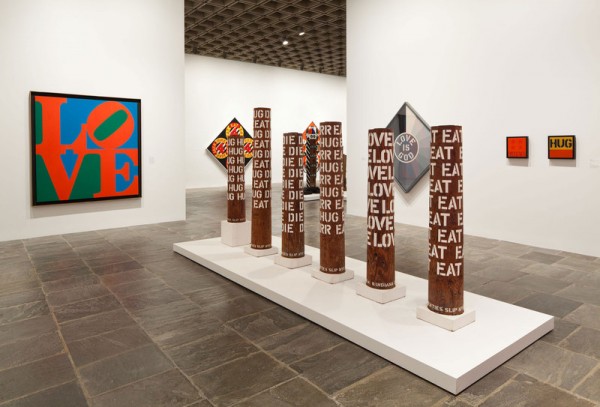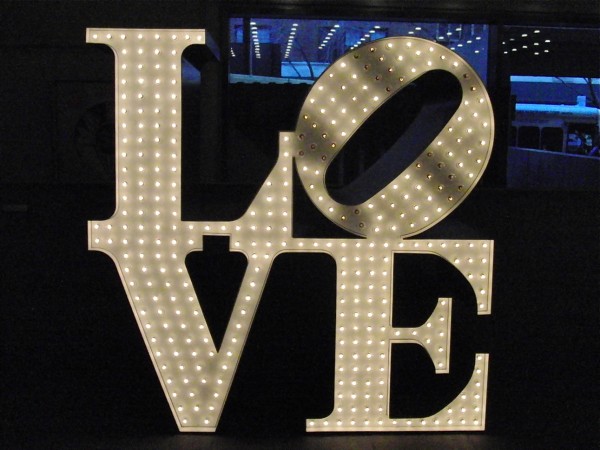
Whitney retrospective reveals there’s a whole lot more to Robert Indiana than one famous word (© 2013 The Morgan Art Foundation, Artists Rights Society / photograph by Sheldan C. Collins)
Whitney Museum of American Art
945 Madison Ave. at 75th St.
Through January 5, $16-$20 (pay-what-you-wish Fridays, 6:00 – 9:00)
212-570-3600
www.whitney.org
Perhaps no other living American contemporary artist has suffered at the hands of an early creation quite the way Robert Indiana has. Robert Clark took on the “nom de brush” Robert Indiana in 1958, naming himself after his home state in tribute to his Midwest roots and shedding the name of the Clarks, who had adopted him as a baby, then divorced when he was eight. In 1965 he created a Christmas card for MoMA in which he painted the word “Love” in red, with blue and green filling the negative space, the first two letters balanced on top of the last two letters, an arrow pointing down in the “V,” the “O” tilted to represent, among other things, the instability of the most human of emotions. The image quickly became a misunderstood icon, eventually appearing on stamps, posters, T-shirts, and other paraphernalia and coming to symbolize the late 1960s and the Summer of Love. All the while, Indiana continued to explore the American Dream, which had let him down in various ways, from his childhood to his problems with the copyright on his “Love” design. The Whitney examines the full scope of Indiana’s career, which is much more than just that one iconic image, in “Robert Indiana: Beyond LOVE,” his first major museum retrospective, which finally arrives more than fifty years after his New York solo debut at the Stable Gallery in 1962. Curated by Barbara Haskell, the eye-catching show begins in the lobby with “The Electric LOVE,” a polychrome aluminum sculpture with dazzling electric lights going on and off like a Times Square billboard, taking Indiana’s central image to the extreme while also getting it out of the way before visitors head upstairs to the fourth floor to see more than one hundred paintings and sculptures, only a few of which contain that four-letter word.

Robert Indiana, “The Electric LOVE,” polychrome aluminum with electric lights, 1966/2000 (photo by twi-ny/mdr)
“I have never made a painting without a message,” Indiana, an air force veteran who is now eighty-five, once said, and indeed, his oeuvre is loaded with meaning. Walking through the exhibit is like taking a trip through twentieth-century America, passing by his herms, cultural mile markers inspired by ancient Greece featuring such stenciled words as “Moon,” “Hub,” “Womb,” and “Hole”; examining maps of Alabama, Mississippi, Louisiana, and Florida surrounded by the sentence “Just as in the anatomy of man every nation must have its hind part,” calling out confederate states that seceded from the Union and where violence against blacks took place during the civil rights movement; and hard-edge, text- and numeral-based canvases from his “American Dream” series that explode with advertising-style bold letters, geometric shapes, and colors with such words and phrases as “Eat” and “Die,” “Tilt,” “Take,” and “666.” Indiana also pays tribute to Charles Demuth, Joseph Stella, Marsden Hartley, Walt Whitman, Henry Wadsworth Longfellow, Herman Melville, and other American artists and writers by incorporating words and/or images associated with them into his works. Also on view are his rarely seen cut-paper costume designs for the Santa Fe Opera’s bicentennial version of Virgil Thomson and Gertrude Stein’s The Mother of Us All, about Susan B. Anthony and the suffragist movement. In addition, Indiana, who left New York City in 1978 for Vinalhaven, Maine, where he still resides, often hides meaning deep within his work; for example, “The Sweet Mystery” includes veiled references to his parents, his homosexuality, a friend who committed suicide, and other personal elements, none of which are apparent in the graphic depiction of two yellow gingko leaves bordered at top and bottom by a red and black warning pattern. And then there it is again, near the end of the show, the spectacular 1966 “LOVE” painting in all its glory, a beautifully rendered emotion that takes on a whole new light in conjunction with the myriad works around it.